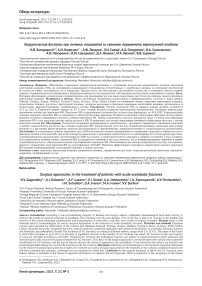Хирургические доступы при лечении пациентов со свежими переломами вертлужной впадины
Автор: Загородний Николай Васильевич, Колесник Александр Иванович, Лазарев Анатолий Федорович, Солод Эдуард Иванович, Очкуренко Александр Алексеевич, Соломянник Ирина Анатольевна, Овчаренко Антон Васильевич, Солодилов Иван Михайлович, Иванов Дмитрий Александрович, Иванов Михаил Александрович, Суриков Владислав Владимирович
Журнал: Гений ортопедии @geniy-ortopedii
Рубрика: Обзор литературы
Статья в выпуске: 5 т.27, 2021 года.
Бесплатный доступ
Введение. Объяснимое стремление травматологов-ортопедов к улучшению результатов оперативного лечения переломов вертлужной впадины (ВВ), по сообщениям подавляющего большинства отечественных и зарубежных авторов, за последние десятилетия не только не теряет актуальности, но и возрастает. Прежде всего, это обусловлено увеличением количества и усилением тяжести данной травмы, сохраняющимися осложнениями и неудовлетворенностью исследователей собственными результатами оперативного лечения. Цель. Изучение обоснований, используемых травматологами, для применения тех или иных оперативных доступов при лечении свежих переломов вертлужной впадины. Материалы и методы. Поиск источников литературы осуществляли в информационных системах и базах данных Pubmed, Embase, Scopus, Medline, Сochran Library, еLibrary, Wiley Online Library по ключевым словам: переломы вертлужной впадины, оперативное лечение, доступы к вертлужной впадине, открытая репозиция и фиксация переломов вертлужной впадины, длительность и кровопотеря, эндопротезирование тазобедренного сустава. Результаты. Частота переломов ВВ, по данным разных авторов, колеблется от 2 до 23,4 %. Причиной данной травмы до 83 % всех случаев являются дорожно-транспортные происшествия. Отмечено значительное увеличение количества переломов ВВ. Переломы ВВ в подавляющем большинстве случаев классифицируют по AO/ASIF. Хирургическому лечению подлежат переломы ВВ со смещением и многоплоскостные переломы. Открытая репозиция и внутренняя фиксация до настоящего времени остаются стандартным способом лечения переломов ВВ. Выбор оперативного доступа проводится чаще с учетом классификации переломов ВВ, а тип перелома диктует выбор доступа к ВВ. Установлено, что авторы вынуждены применять оперативные доступы с учетом переломов колонн ВВ. Обсуждение. Отмечается сохранение приверженности травматологов - ортопедов стандартам в отношении показаний к выбору хирургических доступов при сложных переломах ВВ. Хирургические доступы для лечения двухколонных переломов вертлужной впадины и в настоящее время являются зачастую расширенными и травматичными, продолжительными и сопровождаются кровопотерей. Заключение. В оперативном лечении переломов таза и ВВ большинство авторов придерживается стандартных подходов в выборе доступа и фиксации колонн и отломков ВВ, при этом отмечается единодушие в признании травматичности и «расширенности» используемых доступов, сопровождающихся кровопотерей, достигающей до 2000 мл и более, а продолжительность операции в среднем составляет 3 часа 50 минут. Для оперативного лечения свежих переломов ВВ исследователи применяли как классические, так и модифицированные передние и задние оперативные доступы с обязательным учетом классификации переломов ВВ. Обоснованием для выбора оперативного доступа, как правило, являлось определение типа перелома ВВ по классификации AO/ASIF. Наиболее эффективным подходом в оперативном лечении переломов ВВ признан комбинированный, сочетающий передние и задние доступы.
Переломы, вертлужная впадина, оперативное лечение, хирургические доступы, открытая репозиция, фиксация, эндопротезирование, тазобедренный сустав
Короткий адрес: https://sciup.org/142231587
IDR: 142231587 | УДК: 616.718.16-001.5-089.227.844(048.8) | DOI: 10.18019/1028-4427-2021-27-5-610-619
Текст обзорной статьи Хирургические доступы при лечении пациентов со свежими переломами вертлужной впадины
Актуальность лечения переломов вертлужной впадины (ВВ) обусловлена несколькими факторами – ростом дорожного травматизма, увеличением количества и утяжелением данной травмы, проблемой лечения переломов ВВ у пожилых пациентов, высокой травматичностью используемых доступов, сохраняющимися осложнениями и неудовлетворенностью результатами оперативного лечения [1–6]. D. Butterwick et al. отмечают, что гериатри- ческие пациенты являются самой быстрорастущей подгруппой пациентов с переломами ВВ, при этом частота ее переломов у пациентов старше шестидесяти лет за последние четверть века увеличилась в 2,4 раза [5].
Цель . Изучение обоснований, используемых травматологами, для применения тех или иных оперативных доступов при лечении свежих переломов вертлужной впадины.
МАТЕРИАЛЫ И МЕТОДЫ
Поиск источников литературы осуществляли в информационных системах и базах данных Pubmed, Embase, Scopus, Medline, Сochran Library, еLibrary, Wiley Online Library. Ключевые слова, используемые при поиске: переломы вертлужной впадины, оперативное лечение, доступы к вертлужной впадине, открытая репозиция и фиксация переломов вертлужной впадины, длительность и кровопотеря, эндопротезирование тазобедренного сустава. Период опубликования задан не был. Было проанализировано 59 источников, 48 из которых опубликовано в журналах, индексируемых Scopus.
РЕЗУЛЬТАТЫ
Частота переломов ВВ, по данным разных авторов, колеблется от 2 до 23,4 % [1]. Многие авторы отмечают, что основной причиной данной травмы являются дорожно-транспортные происшествия [1, 2, 6–9]. Переломы ВВ одни исследователи относят к высокоэнергетическим переломам [1, 6, 8, 9], другие – к низкоэнергетическим [10, 11]. J. Jr. Borrelli and J. O. Anglen отмечают, что пожилые пациенты, хотя и вовлечены в высокоэнергетические механизмы травмы, причем с возрастающей частотой, при этом, довольно часто переломы вертлужной впадины у них происходят от низкоэнергетических механизмов, таких как падение на землю, при столкновениях во время игры в гольф [5, 12]. По данным проведенного исследования T.A. Ferguson et al. (2010), высокоэнергетические механизмы составили 82 % (884) из наблюдаемых 1072 переломов ВВ у молодых и взрослых [13]. Отмечена закономерность бимодального распределения переломов ВВ по возрасту, при этом первый пик – это переломы у молодых людей, которые являются результатом высокоэнергетической травмы, тогда как второй пик переломов возникает у пожилых от низкоэнергетических воздействий [4]. В публикациях приводятся данные о значительном увеличении количества переломов ВВ, особенно у лиц пожилого возраста [10, 12, 14]. Возраст пациентов с переломами ВВ варьировал от 19 до 90 лет. Э.И. Солод и соавт. (2009) приводят примеры оперативного лечения пациентов в возрасте 19–49 лет [15], R.D. Stibolt et al. (2018) указывают возраст от 19 до 90 лет, при этом средний возраст составил 51,5 года [16]. Walley K.C et al. (2018) провели исследование по сравнению результатов оперативного и неоперативного лечения переломов вертлужной впадины у пожилых пациентов (> 75 лет) и тяжелых ко-морбидных, более молодых больных (> 65 лет) пациентов [17]. В своем исследовании Verbeek D.O. et al. (2018)
указывают на средний возраст пациентов, которым выполнена открытая репозиция и внутренняя фиксация – 51 год, при этом мужчин было 72 % [18], а R. Firoozabadi et al. (2017) анализировали результаты лечения 156 пациентов старше 65 лет (средний возраст 78 лет) [18]. T. Borg et al. (2019) в анализе краткосрочных результатов открытой репозиции и внутренней фиксации переломов ВВ отмечают средний возраст пациентов 72 года (от 50 до 89) [20]. С целью наиболее полной характеристики наблюдаемых переломов ВВ исследователи использовали разные классификации, в том числе и классификацию R. Judet и E. Letournel [21–26], другие использовали классификацию по AO/ASIF [2, 15, 31]. Чтобы получить лучшее представление о характере перелома, оценивать степень смещения отломков до и после оперативного лечения в обязательном порядке проводилось рентгенологическое обследование пациентов с выполнением компьютерной томографии (КТ) с двух- и трехмерной реконструкцией поврежденной ВВ и тазобедренного сустава в целом. Это позволило всесторонне оценивать все повреждения, их стабильность, состояние костно-хрящевых структур вертлужной впадины и конгруэнтности в тазобедренном суставе (ТБС) [3, 13, 18, 27–29].
Хирургическому лечению подлежат переломы ВВ со смещением и многоплоскостные переломы [3, 15, 29–31]. Открытая репозиция и внутренняя фиксация (в иностранной литературе используется аббревиатура ORIF – open reductionn and internal fixation) до настоящего времени остаются стандартным способом лечения переломов ВВ [22, 30, 32, 33]. Еще Е. Letournel (1980) писал, что идеальная открытая репозиция является методом выбора для лечения переломов ВВ со смещением [22].
Сроки выполнения хирургических вмешательств при переломах ВВ составили от 4 до 35,9 дня с момен- та травмы [24, 28, 29, 31, 34, 35]. А.Ф. Лазарев и соавт. в своей работе отмечают, что если «при выполнении операции в первые 3 недели с момента травмы (до формирования зрелого рубца) хороших и отличных результатов возможно достичь примерно в 80 % случаев, то при вмешательстве, проведенном более чем через 3 недели, эта цифра составляет всего 65 %» [30].
Выбор оперативного доступа проводился авторами с учетом классификации переломов по AO/ASIF [2, 8, 15, 31, 36] или по E. Letournel [24–26, 34, 35, 37]. Тип перелома диктует выбор доступа к ВВ [22]. M. Erem et al. (2019) считают, что для улучшения функциональных результатов выбор одного или двух доступов должен быть определен на основе типа и локализации перелома [25].
При рассмотрении опубликованных работ было установлено, что исследователи, имея накопленный опыт лечения переломов ВВ, применяли оперативные доступы, прежде всего, с учетом переломов колонн ВВ, как изолированных – передней, задней, и так и при одновременных переломах передней и задней колонн [38– 43]. Нами отмечено, что при переломах только передней колонны ВВ в некоторых исследованиях авторы использовали такой же доступ, как и в случаях сочетания переломов передней колонны и передней стенки ВВ, а при переломах задней колонны использовали такой же доступ, как и в случаях сочетания переломов задней колонны и задней стенки ВВ [39–44]. Е. Letournel (1980) приводит информацию, что «до 1965 года разрез Смита-Петерсена или его модификация, называемая илио-феморальным доступом, обеспечивала единственный доступ к верхней части передней колонны вертлужной впадины» [22]. Тем не менее, в публикации T.В. Alton и A.O. Gee (2014) акцентировано внимание на том, что к настоящему времени не определены оптимальные хирургические доступы для каждой модели перелома и нет удобного универсального оперативного доступа, который бы позволил одновременный легкий подход к обеим колоннам ВВ [38].
В случаях переломов передней колонны и передней стенки ВВ, как правило, авторы применяли подвздошно-паховый доступ или доступ Стоппа [10, 39, 43, 45–47]. P. Kloen et al. (2002) однозначно утверждают, что классический подвздошно-паховый подход хорошо зарекомендовал себя при лечении переломов ВВ [42].
Deng C. at аl. (2018) в 31 случае оперативного лечения переломов ВВ применили комбинацию подвздошнопахового и Кохера-Лангенбека доступов [24].
М. Rickman et al. (2012) в случаях, когда была необходима ORIF передних отделов таза больного оперировали в положении на спине с использованием модифицированного доступа Stoppa через поперечный разрез кожи. При переломах передней колонны ВВ, распространяющихся выше передней верхней ости подвздошной кости, применяли подвздошно-паховый (илио-ингвинальный), не расширенный доступ [10].
При переломах задней колонны и задней стенки ВВ некоторые авторы, как правило, выполняют доступ Кохера-Лангенбека, а при переломах передней колонны – подвздошно-паховый [38, 45–47]. Так Lukas Negrin et al. (2017) считают доступ Кохера-Лан-генбека «золотым» стандартом для заднего доступа к тазобедренному суставу и задней колонне ВВ [8]. В случае сочетания переломов обеих колонн, одни авторы вначале осуществляли открытую репозицию и погружной остеосинтез передней колонны из подвздошно-пахового доступа в положении пациента на спине, а затем – задней колонны из доступа Кохера-Ланген-бека с переводом пациента в положение на боку, или, наоборот, т.е. последовательность применения доступов зависела от величины основного смещения [8, 10, 34]. Другие авторы предпочитали выполнять вначале доступ Кохера-Лангенбека, а затем подвздошно-паховый [47]. Э.И. Солод и соавт. при поперечных переломах и переломах передней колонны ВВ использовали подвздошно-паховый доступ, а в случаях переломов типа С применяли расширенный бедренный доступ, при переломах типа С2 и С3 использовали Y-образный доступ [15]. Wang P. et al. (2016) при переломах обеих колонн ВВ пользовались модифицированным подвздошно-паховым доступом в сочетании с доступом Кохера–Лангенбека [34]. М. Rickman et al. (2012) в своих исследованиях при переломе задней колонны ВВ успешно использовали доступ Кохера–Лангенбека для одновременного выполнения ORIF и первичного ЭП ТБС [10]. Еrem M. at аl. (2019) в 65,4 % (n = 26) случаев сочетанных переломов ВВ использовали только один доступ и в остальных случаях (34,4 % / n = 17) обоснованно были вынуждены использовать два доступа [25].
ОБСУЖДЕНИЕ
Было решено, что для лучшего ознакомления с хирургическими доступами, применяемыми для лечения переломов ВВ, обоснованиями применения доступов, необходимо провести анализ опубликованных работ по этой теме за период, начиная с 1964 года, когда вышла работа R. Judet, J. Judet, Е. Letournel (1964), ознаменовавшая появление анатомической классификации переломов вертлужной впадины (позже усовершенствованной Е. Letournel), в которой автор выделил 4 типа простых и 2 типа сочетанных («ассоциированных» – в трактовке автора) переломов, и описания оперативного доступа к ней [21], о чем свидетельствуют публикации [9, 40, 43, 48, 49]. При этом, проследить, менялось ли отношение специалистов, даже с учетом классифицированных переломов, к выбору доступов к ВВ на протяжении этого времени, и выяснить, какие обоснования для выбора показаний к тому или иному доступу ис- пользовали авторы публикаций. Учитывая, что объять необъятное невозможно и лимитирование списка литературы, мы ограничились анализом лишь некоторых доступных исследований по освещаемому вопросу. В представленной таблице 1 и на рисунке 1 мы постарались отобразить примененные исследователями классические и модифицированные доступы к ВВ, при этом, ни в коем случае не претендуем на совершенство приведенной таблицы. Однако объективный анализ данных авторских публикаций позволил нам сделать некоторые выводы. Нами проанализированы отечественные и зарубежные статьи, начиная с 1964 года [21], в том числе 33 за последние 5 лет. В таблицу включено 24 автора. К критериям включения авторов в таблицу мы отнесли, во-первых, использование наиболее часто применяемых в практике [48] стандартных и модифицированных доступов к ВВ. Во-вторых, мы решили осветить особен- ности применения доступов к вертлужной впадине (что отмечено нами в выводах) на протяжении нескольких условных периодов: 1964 – 1980 – 1995 – 2000, 2001 – 2010 и 2011 – 2019, чтобы понять, изменялись ли они с учетом временных периодов. Понятно, что таблица не бесконечна, и мы не могли включить всех цитируемых исследователей. В-третьих, в тексте статей указанных в таблице авторов мы находили в большей степени полную необходимую информацию и получали ответы на собственные вопросы, в сравнении с другими авторами. В-четвертых, выбирались те авторы, которые более подробно описывали сами доступы, их тонкости, показания к доступам, осложнения, связанные с доступами, что для нас было важно. В-пятых, авторы приводили в своих работах наибольшее количество наблюдений применения того или иного доступа к вертлужной впадине, что также немаловажно. В-шестых, статьи указанных в таблице авторов были опубликованы в указанные нами временные периоды.
В таблице 2 учтены приведенные в научных исследованиях переломы ВВ, классифицированные по Е. Letournel [22]. Как правило, во всех исследованиях авторы выделяли изолированные и «ассоциированные» переломы ВВ (передняя колонна и передняя стенка) [9, 40, 43, 46, 48 49], а также в сочетании с переломами головки и шейки бедренной кости (табл. 2) [32, 46, 47, 50]. По данным опубликованных исследований, оперативные доступы применялись согласно диагностированных, а затем и классифицированных переломов ВВ, которые отражены в таблице 2 и на рисунке 2. К сожалению, мы не смогли включить в таблицу 2 (чтобы ее не перегружать) переломы ВВ, сопровождающиеся вывихом головки бедренной кости, и считаем это одним из недостатков.
Таблица 1
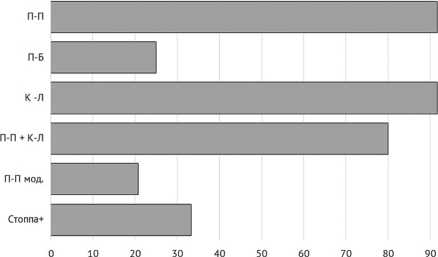
Рис. 1. Гистограмма частоты применения доступов к ВВ
Используемые доступы к вертлужной впадине и количество операций при различных доступах
|
Авторы, № источника |
Количество операций при различных доступах к вертлужной впадине по данным авторов |
|||||||
|
Операций всего |
1 |
2 |
3 |
4 |
5 |
6 |
7 |
|
|
Judet R. et аl., 1964 [21] |
173 |
n* / 129 |
n* / 129 |
n* / 129 |
||||
|
Letournel E., 1980 [22] |
582 |
n* |
n* |
n* |
||||
|
Letournel E., 1993 [7] |
195 |
178 |
17 |
|||||
|
Cole J. at аl., 1994 [39] |
55 |
55 |
||||||
|
Matta J.M., 1996 [41] |
262 |
n* / 259 |
n* / 259 |
n* / 259 |
4 |
|||
|
Kloen P. et аl., 2002 [42] |
15 |
n* |
n* |
|||||
|
Matta JM, 2006 [54] |
373 |
211 |
159 |
3 |
||||
|
Harris AM et аl., 2008 [44] |
51 |
n* |
n* |
|||||
|
Andersen RC et аl., 2010 [45] |
17 |
17 |
||||||
|
Rickman M. et аl., 2012 [12] |
12 |
n* |
n* |
n* |
||||
|
Yang Y. et аl., 2015 [46] |
46 |
26 |
20 |
|||||
|
You-Shui Gao et аl., 2015 [47] |
61 |
49 |
12 |
|||||
|
Boelch S. et аl., 2016 [32] |
23 |
3 |
20 |
|||||
|
Wang P. et аl., 2016 [34] |
73 |
27 |
73 |
27 |
46 |
|||
|
Clarke-Jenssen J. et аl., 2017 [49] |
285 |
n* |
n* |
n* |
||||
|
Reza Firoozabadi et аl., 2017 [19] |
409 |
282 |
119 |
8 |
||||
|
Deng C. et аl., 2018 [24] |
31 |
7 |
13 |
7 |
||||
|
Salama W. et аl., 2018 [55] |
18 |
17 |
1 |
|||||
|
Borg T. et аl., 2019 [20] |
27 |
8 |
5 |
1 |
2 |
|||
|
Еrem M. et аl., 2019 [25] |
47 |
17 |
18 |
11 |
1 |
|||
|
Frietman B. et аl. , 2019 [26] |
220 |
99 |
9 |
83 |
29 |
|||
|
Lont, T. et аl., 2019 [9] |
59 |
25 |
34 |
|||||
|
Boudissa M. et аl., 2019 [51] |
73 |
n*/38 |
n*/38 |
n*/38 |
||||
|
Kilinc CY et аl., 2019 [48] |
63 |
63 |
||||||
Обозначения: доступ к вертлужной впадине: 1 – подвздошно-паховый; 2 – подвздошно-бедренный; 3 – Кохера-Лангенбека; 4 – подвздошно-паховый + Кохера-Лангенбека; 5 –подвздошно-паховый модифицированный; 6 – подвздошно-паховый + Смитта-Петерсона; 7 – Стоппа модифицированный. Примечание: n* – неизвестная часть случаев от абсолютного числа.
Таблица 2
Встречаемость переломов вертлужной впадины (классифицированных по Е. Letournel) по данным авторов публикаций
|
Авторы, № источника |
Количество переломов вертлужной впадины по данным авторов |
|||||||||||
|
Всего |
1 |
2 |
3 |
4 |
5 |
6 |
7 |
8 |
9 |
10 |
11 |
|
|
Judet R. et аl., 1964 [21] |
173 |
9 |
57 |
17 |
74 |
16 |
||||||
|
Letournel E., 1980 [22] |
195 |
n* / 39 |
n* / 39 |
n* / 98 |
n* / 39 |
n* / 39 |
n* / 98 |
39 |
n* / 98 |
n* / 39 |
n* / 98 |
98 |
|
Letournel E., 1993 [7] |
582 |
27 |
157 |
18 |
27 |
15 |
37 |
43 |
56 |
134 |
131 |
|
|
Cole J. at аl., 1994 [39] |
55 |
n* |
n* |
n* |
n* |
n* |
n* |
n* |
||||
|
Matta J.M., 1996 [41] |
92 |
n* |
n* |
n* |
n* |
35 % |
||||||
|
Kloen P. et аl., 2002 [42] |
15 |
3 |
1 |
4 |
7 |
|||||||
|
Matta J.M., 2006 [56] |
373 |
15 |
20 |
7 |
22 |
2 |
22 |
71 |
20 |
67 |
127 |
|
|
Harris AM et аl., 2008 [44] |
51 |
13 |
2 |
10 |
3 |
23 |
||||||
|
Andersen RC et аl., 2010 [45] |
17 |
n* |
n* |
|||||||||
|
Rickman M. et аl., 2012 [12] |
12 |
2 |
2 |
3 |
4 |
1 |
||||||
|
Yang Y. et аl., 2015 [46] |
46 |
31 |
||||||||||
|
You-Shui Gao et аl., 2015 [47] |
61 |
2 |
7 |
3 |
1 |
0 |
0 |
6 |
4 |
7 |
31 |
|
|
Boelch S. et аl., 2016 [32] |
32 |
3 |
1 |
3 |
1 |
n* / 7 |
n* / 7 |
15 |
||||
|
Wang, P. et аl., 2016 [34] |
73 |
15 |
21 |
11 |
26 |
|||||||
|
Clarke-Jenssen J. et аl., 2017 [49] |
99 |
n* |
n* |
n* |
n* |
n* |
n* |
n* |
n* |
n* |
n* |
|
|
Reza Firoozabadi et аl., 2017 [19] |
409 |
9 |
283 |
107 |
||||||||
|
Deng C. et аl., 2018 [24] |
31 |
0 |
0 |
0 |
0 |
0 |
0 |
8 |
5 |
6 |
12 |
|
|
Salama W. et аl., 2018 [58] |
18 |
1 |
12 |
2 |
3 |
1 |
||||||
|
Borg T. et аl., 2019 [20] |
27 |
0 |
5 |
1 |
0 |
0 |
0 |
12 |
0 |
0 |
2 |
7 |
|
Еrem M. et аl., 2019 [25] |
47 |
n* / 21 |
n* / 21 |
n* / 26 |
n* / 21 |
n* / 21 |
n* / 26 |
n* / 26 |
n* / 26 |
n* / 21 |
n* / 26 |
n* / 26 |
|
Frietman B. et аl. , 2019 [26] |
220 |
3 |
38 |
17 |
27 |
21 |
33 |
14 |
7 |
23 |
37 |
|
|
Lont, T. et аl., 2019 [9] |
59 |
1 |
3 |
3 |
5 |
1 |
0 |
3 |
35 |
1 |
1 |
6 |
|
Boudissa M. et аl., 2019 [51] |
38 |
3 |
6 |
1 |
8 |
0 |
0 |
11 |
0 |
0 |
4 |
5 |
|
Kilinc CY. et аl., 2019 [48] |
63 |
0 |
0 |
0 |
5 |
2 |
0 |
7 |
12 |
10 |
0 |
27 |
Обозначения: перелом вертлужной впадины: 1 – задняя колонна; 2 – задняя стенка; 3 – задняя колонна + задняя стенка; 4 – передняя колонна; 5 – передняя стенка; 6 – передняя колонна + передняя стенка; 7 – передняя колонна + передняя стенка + полупоперечный перелом задней стенки; 8 – Т-образный перелом; 9 – поперечный перелом; 10 – поперечный перелом задней стенки; 11 – перелом обеих колонн. Примечание: n* – неизвестная часть случаев от абсолютного числа.
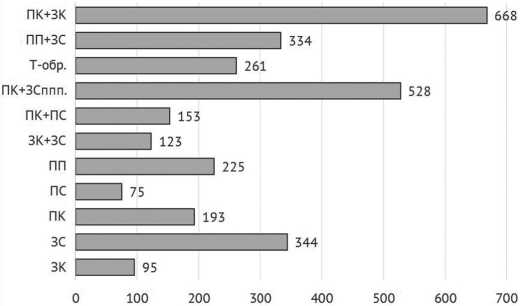
Рис. 2. Диаграмма встречаемости изолированных и сочетанных переломов ВВ
Передние доступы использовали как при простых/ элементарных переломах ВВ (передняя колонна, передняя стенка), так и при сочетанных переломах (передняя колонна и передняя стенка) [9, 40, 43, 48, 49] в сочетании с переломами головки и шейки бедренной кости [46, 47, 49, 50]. Из передних доступов, начиная с 1964 и по 2019 год, авторы чаще применяли подвздошно-паховый, в том числе подвздошно-паховый модифицированный [9, 19, 21, 24]. В своих объемных исследованиях, касающихся отдаленных результатов ORIF и эндопротезирования ТБС, Ferguson T.A. (2010) и Clarke-Jenssen et al. (2017) делают акцент на подробной характеристике классифицированных по Е. Letournel переломов ВВ, однако мы не нашли использованные хирургические доступы в данных источниках [13, 49]. По мнению Harris AM at аl. (2008), некоторые сложные переломы ВВ эффективно оперируют с использованием одного доступа, однако некоторые сочетания переломов требуют более широкого подхода. Одновременное применение переднего и заднего доступов может быть безопасной и полезной альтернативой расширенным доступам. Авторы указывают на преимущества комбинированного подхода с сочетанием передних и задних доступов при поперечных переломах задней стенки с широким передним смещением, переломах типа Т со значительным передненижним смещением или переломах обеих колонн с вовлечением задней стенки [44]. О преимуществах одновременного применения переднего и заднего доступов докладывают и другие авторы [24, 25, 40, 51, 52]. В таблицу 1 не включены редко приводимые в публикациях доступы или редкое сочетание доступов, а именно: Олье, Смита-Петерсена, Ватсон-Джонса, Хардинга, параректальный и сочетание доступов: Стоппа и Кохера – Лангенбека, использованные одним или двумя авторами [24, 37, 42, 50, 53].
Комбинированное использование передних и задних доступов обусловлено, в первую очередь, сложностью переломов ВВ, значительным смещением колонн и отломков, трудностями визуализации всех повреждений при выполнении репозиции и остеосинтеза [21, 40, 52]. Одновременное применение передних и задних доступов создавало условия для хорошего обзора поврежденных отделов ВВ, позволяло хирургам выполнить адекватную репозицию обеих колонн и отломков и выполнить их остеосинтез, а при необходимости и первичное эндопротезирование ВВ [42, 50, 56–58]. За- служивает внимания исследование P. Kloen et al. (2019), в котором авторы описывают технику «открытия» тазобедренного сустава с подвывихом или вывихом головки бедренной кости путем аддукции и наружной ротации ноги с «нежной» тракцией бедра. Эта технология позволила авторам осуществить оценку суставных поверхностей головки бедренной кости и ВВ, осмотр хрящевой губы ВВ, выполнить вправление и фиксацию отломков под внутрисуставным визуальным контролем [42]. Необходимо отметить, что многие исследования содержат данные о результатах применения модифицированных доступов к ВВ [12, 35, 37, 39, 45, 46]. Wang P. et al. (2019) при исследовании модифицированного подвздошно-пахового доступа отмечают при этом, что рутинные доступы к ВВ имеют серьезные осложнения, связанные с длительностью оперативного вмешательства, травмати-зацией, в том числе, пахового нервно-сосудистого пучка и лимфатических структур, большой потерей крови, развитием хирургической инфекции, образованием грыж и гетеротопических оссификатов.
Авторы также указывают, что модифицированный подвздошно-паховый доступ в сочетании с подходом Кохера–Лангенбека предполагает меньшее время для выполнения операции, меньший объем кровопотери и количество осложнений [34]. Здесь уместно сказать, что многие авторы отмечают значительную кровопотерю при ORIF переломов ВВ, которая достигает от 600 до 2000 мл и более, а продолжительность операции, как правило, превышает 2 часа, и в среднем составляет 3 часа 50 минут [8, 12, 14, 34, 35].
Kloen P. et al. (2002) излагают три основные, по их мнению, причины, которые послужили основой для модификации подвздошно-пахового доступа. Во-первых, в случаях мелкооскольчатых переломов передней стенки или нижних отделов передней колонны нет возможности хорошей визуализации для обеспечения точной анатомической репозиции и внутренней фиксации – в классическом подвздошно-паховом доступе это ограничение обусловлено подвздошно-поясничной мышцей. Во-вторых, нет возможности для интраартикулярной визуализации при использовании подвздошно-пахового доступа, который предполагает конгруэнтность сустава оценивать по состоянию видимой внесуставной поверхности сустава. В-третьих, мобилизация подвздошно-поясничной мышцы при классическом подвздошно-паховом доступе требует отделения подвздошно-капсулярной мышцы («подвздошно-капсулярной мышцы» – цит. по автору) от подвздошной мышцы. И, наконец, частое послеоперационное осложнение в виде травмы наружного кожного бедренного нерва, что может быть неприятной проблемой для пациента и хирурга. При этом авторы отмечают, что модификация подвздошно-пахового доступа является полезным дополнением к арсеналу хирургии вертлужной впадины и тазобедренного сустава при отдельных типах переломов и явно не предлагает заменить классический подвздошно-паховый доступ, а скорее расширить его универсальность в конкретных случаях [42]. Ряд авторов в своих исследованиях результатов лечения переломов ВВ применяли технику модифицированного доступа Стоппа [12, 25, 39, 43, 45, 48]. S. McDowell et al. (2012) в ретроспективном клиническом исследовании описывает результаты примене- ния модифицированного транстрохантерного доступа Олье в 95 случаях лечения переломов ВВ. Из преимуществ технологии автор указывает на хороший обзор проксимального отдела подвздошной кости и полный обзор ВВ [37]. J. Chen et al. (2019) считают, что латерально-прямой доступ к ВВ представляет собой альтернативу подвздошно-паховому доступу у пациентов пожилого возраста [53]. В плане освещения отдельных случаев и пока редкий случай применения атроскопии при открытой репозиции переломов передних отделов ВВ описан Y. Kazushige et al. (2016). Одновременное использование артроскопии позволило авторам уменьшить травматичность и повысить эффективность основного переднего доступа [57].
Особое внимание в своих исследованиях авторы уделяли хирургическим доступам у пожилых пациентов с переломами ВВ. J. Chen et al. (2019) при использовании параректального («латерально-ректального» – цит. по автору) доступа у пожилых пациентов с переломами ВВ получили хорошие функциональные и рентгенологические результаты и низкий уровень осложнений [53]. Ряд авторов при лечении переломов ВВ у пожилых пациентов успешно применял сочетание переднего подвздошно-пахового доступа с доступом Кохера-Лангенбека для одновременного выполнения ORIF и первичного эндопротезирования ТБС [6, 49, 51, 53, 55].
На рисунке 3 представлена гистограмма частоты применяемых хирургических доступов в процентах на протяжении 4-х временных периодов.
На рисунке 4 представлена гистограмма количества выполненных оперативных вмешательств с привязкой доступов к ВВ.
Надо признать, что обозначенные в гистограмме на рисунке 3 данные, к сожалению, полностью не отражают реальную действительность применения доступов к ВВ по понятным всем нам причинам, т.к. не все авторы публикуют свои материалы, нет у нас реальной возможности найти весь опубликованный и достоверный материал по данной теме. И в то же время можно четко отметить, что наиболее часто продолжают использоваться подвздошно-паховый доступ (27–51 %), доступ Кохера-Лангенбека (16–40 %), подвздошно-паховый модифицированный (5–33 %) и сочетание подвздошно-пахового и Кохера-Лангенбека доступов в 11 % случаев.
Отмечено, что подвздошно-паховый доступ на протяжении 4-х периодов применялся практически с равной частотой с небольшими колебаниями, что зависело, на наш взгляд, от количества травм и характера переломов. Доступ Кохера-Лангенбека также равномерно использовался в эти периоды, но с меньшей частотой.
Определенный интерес представляет гистограмма на рисунке 4, где отмечено количество выполненных оперативных вмешательств использованием разных доступов и привязкой к годам. В последние два десятилетия четко прослеживается доминирование количества выполненных операций с использованием подвздошно-пахового, Кохера-Лангенбека доступов и сочетания последних, и отмечен рост оперативных вмешательств с применением модифицированных подвздошно-пахового и Стоппа доступов и резкое снижение количества выполненных операций с использованием подвздошно-бедренного доступа.
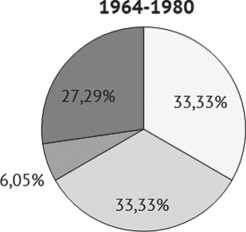
1981-2000
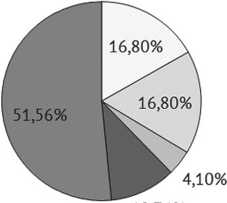
10,74%
2001-2010
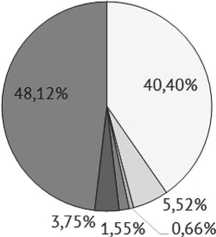
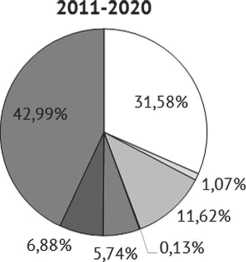
-
□ К-Л
-
□ П-Б
-
□ П-П и К-Л
-
■ П-П и С-П
-
□ П-Пмод.
-
□ Стоппа мод.
-
□ П-П
Рис. 3. Гистограмма частоты применяемых хирургических доступов в процентах на протяжении 4-х временных периодов
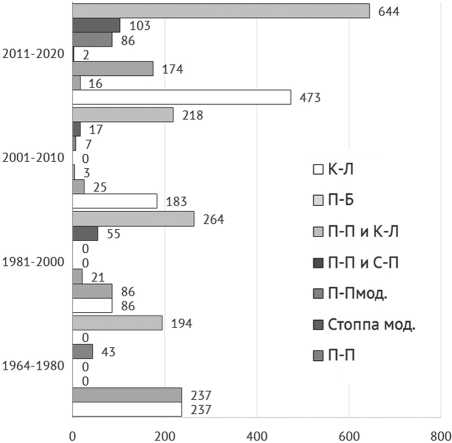
Рис. 4. Гистограмма количества выполненных оперативных вмешательств с привязкой доступов к ВВ
В последние годы четко прослеживается тенденция исследователей к первичному эндопротезированию ТБС при смещенных переломах ВВ, что является лучшим вариантом лечения в связи с возможностью ранней мобилизации пациентов и профилактики осложнений, связанных с постельным режимом [9, 19, 50, 51, 57, 59]. M. Rickman et al. (2012) и Mehdi Boudissa et al. (2019) из заднего доступа Кохера-Лангенбека выполняли эндопротезирование ТБС, а из переднего подвздошно-пахового доступа – ORIF [10, 51]. Подобная тактика является оправданной многими авторами, особенно при лечении пожилых пациентов [11, 12, 13, 20, 32, 33]. Wael Salama et al. (2018) у 18 пациентов одновременно выполняли ORIF и эндопротезирование тазобедренного сустава из доступа Кохера-Лангенбека. Надо отметить, что первым шагом в случаях выполнения эндопротезирования была резекция шейки бедренной кости для визуализации фрагментов вертлужной впадины, которые были предварительно вправлены и зафиксированы спицами Киршнера [55].
ЗАКЛЮЧЕНИЕ
Частота переломов ВВ колеблется от 2 до 23,4 %, и, по данным ряда авторов, они относятся к высокоэнергетическим, причем в 83 % всех случаев причиной данной травмы являются дорожно-транспортные происшествия. Хирургическому лечению подлежат переломы ВВ со смещением и многоплоскостные переломы. Открытая репозиция и внутренняя фиксация (в иностранной литературе используется аббревиатура ORIF – open reduction and internal fixation) до настоящего времени остаются стандартным способом лечения переломов вертлужной впадины. Выбор оперативного доступа проводится чаще с учетом классификации переломов по AO/ASIF. Для улучшения функциональных результатов выбор одного или двух доступов должен быть определен на основе типа и локализации перелома. Все авторы применяли классические оперативные доступы к ВВ с учетом классификации переломов. Наиболее эффективным, с учетом мнения большинства цитируемых авторов, в оперативном лечении переломов ВВ признан комбинированный подход с сочетанием передних и задних доступов. Комбинированное использование передних и задних доступов обусловлено, в первую очередь, сложностью переломов ВВ, значительным смещением колонн и отломков, при этом создаются условия для хорошей визуализации практически всех поврежденных отделов ВВ, что позволяет хирургам выполнить адекватную открытую репозицию и остеосинтез обеих колонн и отломков, а, при необходимости, и первичное эндопротезирование тазобедренного сустава. Из цитируемых авторов подвздошно-паховый доступ приме- няли 17 (70,8 %). Модифицированные варианты практиковались 5 (20,8 %) авторами, а, в целом, с учетом одновременного применения авторами доступа Кохера-Лангенбека – 12 (50 %), доступ применялся 22 (91,7 %) авторами. Наравне практиковали и доступ Кохера-Лан-генбека, который был применен 17 (70,8 %) авторами в изолированном варианте и в сочетании с подвздошнопаховым доступом – 12 (50 %), и в целом доступ применялся 22 (91,7 %) авторами. Доступ Стоппа, как в «чистом» виде, так и в сочетании, был применен 8 авторами (33 %). Применение модифицированных классических подвздошно-пахового и Кохера–Лангенбека доступов детерминировано возникающими серьезными интра-и послеоперационными осложнениями, связанными, прежде всего, с длительностью оперативного вмешательства, травматизацией тканей, в том числе, пахового нервно-сосудистого пучка и лимфатических структур, большой потерей крови, развитием хирургической инфекции, образованием грыж и гетеротопических ос- сификатов, и направлено на улучшение визуализации ВВ, особенно в случаях мелкооскольчатых переломов, обеспечение точной анатомической репозиции и внутренней фиксации, точной анатомической репозиции и внутренней фиксации, сокращение времени операции, кровопотери и осложнений. В оперативном лечении переломов ВВ большинство авторов, придерживающихся стандартных классических доступов и фиксации отломков, отмечают их значительную травматичность, сопровождающуюся кровопотерей, достигающей до 2000 мл и более, а продолжительность операции в среднем составляет 3 часа 50 минут, что становится сдерживающим фактором широкого применения в остром периоде травмы, в то же время открытая репозиция и внутренняя фиксация в настоящее время остаются стандартным способом лечения переломов таза и ВВ. По нашему мнению, поиск альтернативного подхода в оперативном лечении пусть не всех, а некоторых типов переломов ВВ, будет оправдан.
ВЫВОДЫ
-
1. Для оперативного лечения свежих переломов ВВ исследователи применяли как классические, так и модифицированные передние и задние оперативные доступы с обязательным учетом классификации переломов ВВ. Обоснованием для выбора оперативного доступа, как правило, являлись анатомические особенности и сложность диагностированных переломов ВВ с учетом смещения колонн и отломков, а также типа перелома ВВ, определенного по одной из классификаций.
-
2. При изолированных одноколонных переломах ВВ используют, соответственно, передние или задние доступы. Наиболее эффективным подходом в оперативном лечении сложных и двухколонных переломов ВВ признан комбинированный, сочетающий передние и задние доступы.
-
3. Подвздошно-паховый доступ был применен 17 (70,8 %) исследователями, а, в целом, с учетом одновременного применения доступа Кохера-Лангенбе-ка подвздошно-паховый доступ применен 22 (91,7 %) авторами. Доступ Кохера-Лангенбека применялся
-
4. Комбинированное использование передних и задних доступов обусловлено, в первую очередь, сложностью переломов ВВ, значительным смещением колонн и отломков, при этом создаются условия для хорошей визуализации практически всех поврежденных отделов ВВ, что позволяет хирургам выполнить адекватную открытую репозицию и остеосинтез обеих колонн и отломков, а, при необходимости, и первичное эндопротезирование тазобедренного сустава.
-
5. Разработка и применение модифицированных классических подвздошно-пахового и Кохера–Ланген-бека доступов детерминировано возникающими при их использовании серьезными интра- и послеоперационными осложнениями, связанными, прежде всего, с длительностью оперативного вмешательства, травма-тизацией тканей.
22 (91,7 %) авторами, при этом в 70,8 % был использован в изолированном варианте и в сочетании с подвздошно-паховым доступом (50 %). Модифицированные варианты практиковались в 20,8 % случаев.
Список литературы Хирургические доступы при лечении пациентов со свежими переломами вертлужной впадины
- Гринь А.А., Рунков А.В., Шлыков И.Л. Выбор операционного доступа при лечении двухколонных переломов вертлужной впадины // Травматология и ортопедия России. 2014. № 1 (71). С. 92-97.
- Особенности лечения повреждений таза при политравме / A.B. Бондаренко, И.В. Круглыхин, И.А. Плотников, А.Н. Войтенко, О.А. Жмур-ков // Политравма. 2014. № 3. С. 46-57.
- Белецкий А.В., Воронович А.И., Мурзич А.Э. Определение показаний к оперативному лечению и выбор хирургических доступов при сложных комплексных переломах вертлужной впадины // Вестник травматологии и ортопедии им. Н.Н. Приорова. 2010. Т. 17, № 4. С. 30-37.
- Operative management of acetabulum fractures in the obese patient: challenges and solutions / N.R. Sardesai, M.A. Miller, J.J. Jauregui, C.K. Griffith, R.F. Henn, J.W. Nascone // Orthop. Res. Rev. 2017. Vol. 9. P. 75-81. DOI: 10.2147/0RR.S113424.
- Acetabular fractures in the elderly: evaluation and management / D. Butterwick, S. Papp, W. Gofton, A. Liew, P.E. Beaulé // J. Bone Joint Surg. Am. 2015. Vol. 97, No 9. P. 758-768. DOI: 10.2106/JBJS.N.01037.
- Erden A. Acetabular Fractures - A Review of their Management // J. Trauma & Treatment. 2015. Vol. 4, No 4. DOI: 10.4172/2167-1222.1000278.
- Laird A., Keating J.F. Acetabular fractures: a 16-year prospective epidemiological study // J. Bone Joint Surg. Br. 2005. Vol. 87, No 7. P. 969-973. DOI:10.1302/0301-620X.87B7.16017.
- Negrin L.L., Seligson D. Results of 167 consecutive cases of acetabular fractures using the Kocher-Langenbeck approach: a case series // J. Orthop. Surg. Res. 2017. Vol. 12, No 1. P. 66. DOI: 10.1186/s13018-017-0563-6.
- Changes in gait pattern and hip muscle strength after open reduction and internal fixation of acetabular fracture / M. Kubota, K. Uchida, Y. Kokubo, S. Shimada, H. Matsuo, T. Yayama, T. Miyazaki, N. Takeura, A. Yoshida, H. Baba // Arch. Phys. Med. Rehabil. 2012. Vol. 93, No 11. P. 2015-2021. DOI: 10.1016/j.apmr.2012.01.016.
- The management of complex acetabular fractures in the elderly with fracture fixation and primary total hip replacement / M. Rickman, J. Young, M. Bircher, R. Pearce, M. Hamilton // Eur. J. Trauma Emerg. Surg. 2012. Vol. 38, No 5. P. 511-516. DOI: 10.1007/s00068-012-0231-9.
- Total hip arthroplasty, combined with a reinforcement ring and posterior column plating for acetabular fractures in elderly patients: good outcome in 34 patients / T. Lont, J. Nieminen, A. Reito, T.K. Pakarinen, I. Pajamäki, A. Eskelinen, M.K. Laitinen // Acta Orthop. 2019. Vol. 90, No 3. P. 275280. DOI: 10.1080/17453674.2019.1597325.
- Arthroplasty for the Treatment of Fractures in the Older Patient. Indications and current techniques / Borrelli J. Jr., Anglen J.O., editors. Springer International Publishing. 2018. P. 280. DOI: 10.1007/978-3-319-94202-5.
- Fractures of the acetabulum in patients aged 60 years and older: an epidemiological and radiological study / T.A. Ferguson, R. Patel, M. Bhandari, J.M. Matta // J. Bone Joint Surg. Br. 2010. Vol. 92, No 2. P. 250-257. DOI: 10.1302/0301-620X.92B2.22488.
- Чегуров О.К., Менщиков И.Н. Лечение повреждений вертлужной впадины и их последствий (обзор литературы) // Гений ортопедии. 2018. Т. 24, № 1. С. 95-101. DOI 10.18019/1028-4427-2018-24-1-95-101.
- Возможности оперативного лечения переломов вертлужной впадины с использованием малоинвазивных технологий / Э.И. Солод, А.Ф. Лазарев, А.А. Лазарев, Я.Г. Гупушаури, М.Г. Какабадзе, А.С. Роскидайло, И.М. Дан // Вестник травматологии и ортопедии им. Н.Н. Приорова. 2009. Т. 16, № 2. С. 3-9.
- Total hip arthroplasty for posttraumatic osteoarthritis following acetabular fracture: A systematic review of characteristics, outcomes, and complications / R.D. Stibolt Jr., H.A. Patel, S.R. Huntley, E.J. Lehtonen, A.B. Shah, S.M. Naranje // Chin. J. Traumatol. 2018. Vol. 21, No 3. P. 176181. DOI: 10.1016/j.cjtee.2018.02.004.
- Walley K.C., Appleton P.T., Rodriguez E.K. Comparison of outcomes of operative versus non-operative treatment of acetabular fractures in the elderly and severely comorbid patient // Eur. J. Orthop. Surg. Traumatol. 2017. Vol. 27, No 5. P. 689-694. DOI: 10.1007/s00590-017-1949-1.
- Long-term patient reported outcomes following acetabular fracture fixation / D.O. Verbeek, J.P. van der List, C.M. Tissue, D.L. Helfet // Injury. 2018. Vol. 49, No 6. P. 1131-1136. DOI: 10.1016/j.injury.2018.04.031.
- Acetabular Fractures in the Senior Population - Epidemiology, Mortality and Treatments / R. Firoozabadi, W.W. Cross, J.C. Krieg, M.L.C. Routt // Arch. Bone Jt. Surg. 2017. Vol. 5, No 2. P. 96-102.
- Borg T., Hernefalk B., Hailer N.P. Acute total hip arthroplasty combined with internal fixation for displaced acetabular fractures in the elderly: a short-term comparison with internal fixation alone after a minimum of two years // Bone Joint J. 2019. Vol. 101-B, No 4. P. 478-483. DOI: 10.1302/0301-620X.101B4.BJJ-2018-1027.R2.
- Judet R., Judet J., Letournel E. Fractures of the acetabulum: classification and surgical approaches for open reduction. Preliminary report // J. Bone Joint Surg. Am. 1964. Vol. 46. P. 1615-1646.
- Letournel E. Acetabulum fractures: classification and management // Clin. Orthop. Relat. Res. 1980. No 151. P. 81-106.
- The Relevance of the Judet and Letournel Acetabular Fracture Classification System in the Modern Era: A Review / B.A. Butler, C.D. Lawton, S.Z. Hashmi, M.D. Stover // J. Orthop. Trauma. 2019. Vol. 33, No Suppl 2. P. S3-S7. DOI: 10.1097/BOT.0000000000001401.
- Operative treatment of delayed acetabular fractures through combined anterior and Kocher-Langenbeck approaches / C. Deng, W.D. Ni, S.O. Guo, G. Luo, W. Shui, B. Qiao // Zhonghua Wai Ke Za Zhi. 2018. Vol. 56, No 3. P. 196-200. DOI: 10.3760/cma.j.issn.0529-5815.2018.03.006.
- Effects of the incision preference in acetabular surgery on the postoperative functional outcomes / M. Erem, C. Copuroglu, E. Copuroglu, M. Ciftdemir, M. Ozcan, K. Saridogan // Niger. J. Clin. Pract. 2019. Vol. 22, No 6. P. 862-868. DOI: 10.4103/njcp.njcp_455_18.
- Frietman B., Biert J., Edwards M.J.R. Patient-reported outcome measures after surgery for an acetabular fracture // Bone Joint J. 2018. Vol. 100-B, No 5. P. 640-645. DOI:10.1302/0301-620X.100B5.BJJ-2017-0871.R3.
- Introduction of a three-dimensional computed tomography measurement method for acetabular fractures / A.M.L. Meesters, J. Kraeima, H. Banierink, C.H. Slump, J.P.P.M. de Vries, K. Ten Duis, M.J.H. Witjes, F.F.A. IJpma // PLoS One. 2019. Vol. 14, No 6. P. e0218612. DOI: 10.1371/journal.pone.0218612.
- Surgical treatment of unstable pelvic fractures with concomitant acetabular fractures / L. Cai, Y. Lu, X. Guo, J. Wang // Int. Orthop. 2017. Vol. 41, No 9. P. 1803-1811. DOI: 10.1007/s00264-017-3532-0.
- Long term results after surgical management of posterior wall acetabular fractures / N.K. Magu, P. Gogna, A. Singh, R. Singla, R. Rohilla, A. Batra, R. Mukhopadhyay // J. Orthop. Traumatol. 2014. Vol. 15, No 3. P. 173-179. DOI: 10.1007/s10195-014-0297-8.
- Проблемы лечения переломов вертлужной впадины / А.Ф. Лазарев, Э.И. Солод, Я.Г. Гудушаури, М.Г. Какабадзе, С.С. Стоюхин, И.Н. Сахарных // Вестник травматологии и ортопедии им. Н.Н. Приорова. 2013. Т. 20, № 4. С. 81-85.
- Современные возможности остеосинтеза вертлужной впадины / Э.И. Солод, А.Ф. Лазарев, Я.Г. Гудушаури, М.Г. Какабадзе, И.Н. Сахарных, С.С. Стоюхин // Вестник травматологии и ортопедии им. Н.Н. Приорова. 2014. Т. 21, № 2. С. 25-32.
- Comparison of open reduction and internal fixation and primary total hip replacement for osteoporotic acetabular fractures: a retrospective clinical study / S.P. Boelch, M.C. Jordan, R.H. Meffert, H. Jansen // Int. Orthop. 2017. Vol. 41, No 9. P. 1831-1837. DOI: 10.1007/s00264-016-3260-x.
- Management of acetabular fractures in the geriatric patient / M. Hanschen, S. Pesch, S. Huber-Wagner, P. Biberthaler // SICOT J. 2017. Vol. 3. P. 37. DOI: 10.1051/sicotj/2017026.
- Modified ilioinguinal approach in combined surgical exposures for displaced acetabular fractures involving two columns / P. Wang, X. Zhu, P. Xu, Y. Zhang, L. Wang, X. Liu, W. Mu // Springerplus. 2016. Vol. 5, No 1. P. 1602. DOI: 10.1186/s40064-016-3316-9.
- Internal Fixation of Complicated Acetabular Fractures Directed by Preoperative Surgery with 3D Printing Models / Z.J. Liu, J. Jia, Y.G. Zhang, W. Tian, X. Jin, Y.C. Hu // Orthop. Surg. 2017. Vol. 9, No 2. P. 257-260. DOI: 10.1111/os.12324.
- Tornetta P. 3rd. Non-operative management of acetabular fractures. The use of dynamic stress views // J. Bone Joint Surg. Br. 1999. Vol. 81, No 1. P. 67-70. DOI: 10.1302/0301-620x.81b1.8805.
- Modified Ollier transtrochanteric approach for the treatment of acetabular fractures / S. McDowell, B. Mullis, B.S. Knight, L.E. Dahners // Orthopedics. 2012. Vol. 35, No 2. P. e132-e136. DOI: 10.3928/01477447-20120123-03.
- Alton T.B., Gee A.O. Classifications in brief: Letournel Classification for acetabular fractures // Clin. Orthop. Relat. Res. 2014. Vol. 472, No 1. P. 35-38. DOI: 10.1007/s11999-013-3375-y.
- Cole J.D., Bolhofner B.R. Acetabular fracture fixation via a modified Stoppa limited intrapelvic approach. Description of operative technique and preliminary treatment results // Clin. Orthop. Relat. Res. 1994. No 305. P. 112-123.
- Matta J.M. Operative treatment of acetabular fractures through the ilioinguinal approach. A 10-year perspective // Clin. Orthop. Relat. Res. 1994. No 305. P. 10-19.
- Matta J.M. Fractures of the acetabulum: accuracy of reduction and clinical results in patients managed operatively within three weeks after the injury // J. Bone Joint Surg. Am. 1996. Vol. 78, No 11. P. 1632-1645.
- Kloen P., Siebenrock K.A., Ganz R. Modification of the ilioinguinal approach // J. Orthop. Trauma. 2002. Vol. 16, No 8. P. 586-593. DOI: 10.1097/00005131-200209000-00008.
- A less invasive anterior intrapelvic approach for the treatment of acetabular fractures and pelvic ring injuries / M. Jakob, R. Droeser, R. Zobrist, P. Messmer, P. Regazzoni // J. Trauma. 2006. Vol. 60, No 6. P. 1364-1370. DOI: 10.1097/01.ta.0000208139.97474.f7.
- Simultaneous anterior and posterior approaches for complex acetabular fractures / A.M. Harris, P. Althausen, J.F. Kellam, M.J. Bosse // J. Orthop. Trauma. 2008. Vol. 22, No 7. P. 494-497. DOI: 10.1097/BOT.0b013e3181830d2a.
- Modified Stoppa approach for acetabular fractures with anterior and posterior column displacement: quantification of radiographic reduction and analysis of interobserver variability / R.C. Andersen, R.V. O'Toole, J.W. Nascone, M.F. Sciadini, H.M. Frisch, C.W. Turen // J. Orthop. Trauma. 2010. Vol. 24, No 5. P. 271-278. DOI:10.1097/BOT.0b013e3181b2b4ca.
- Modified ilioinguinal approach to treat pelvic or acetabular fractures: a retrospective study / Y. Yang, Q. Li, H. Cui, Z. Hao, Y. Wang, J. Liu, L. Li, D. Zhou // Medicine (Baltimore). 2015. Vol. 94, No 37. P. e1491. doi: 10.1097/MD.000000000000149L
- Late surgery for acetabular fractures in a Chinese level I trauma centre: surgical experience and outcomes / Y.S. Gao, Z.B. Zhou, M.J. Tang, X.W. Yu, S. Chen, C.Q. Zhang, Y.Q. Sun // Int. Orthop. 2015. Vol. 39, No 9. P. 1865-1871. DOI: 10.1007/s00264-015-2932-2.
- Treatment results for acetabulum fractures using the modified Stoppa approach / C.Y. Kilinc, A.E. Acan, E. Gultac, R.M. Kilinc, O. Hapa, N.H. Aydogan// Acta Orthop. Traumatol. Turc. 2019. Vol. 53, No 1. P. 6-14. DOI: 10.1016/j.aott.2018.11.003.
- Long-term survival and risk factors for failure of the native hip joint after operatively treated displaced acetabular fractures / J. Clarke-Jenssen, O. R0ise, S.A.0. Storeggen, J.E. Madsen // Bone Joint J. 2017. Vol. 99-B, No 6. P. 834-840. DOI: 10.1302/0301-620X.99B6.BJJ-2016-1013.R1.
- Treatment of acetabular fractures in older patients-introduction of a new implant for primary total hip arthroplasty / H. Resch, D. Krappinger, P. Moroder, A. Auffarth, M. Blauth, J. Becker // Arch. Orthop. Trauma Surg. 2017. Vol. 137, No 4. P. 549-556. DOI: 10.1007/s00402-017-2649-3.
- Operative versus non-operative treatment of displaced acetabular fractures in elderly patients / M. Boudissa, F. Francony, S. Drevet, G. Kerschbaumer, S. Ruatti, M. Milaire, P. Merloz, J. Tonetti // Aging Clin. Exp. Res. 2020. Vol. 32, No 4. P. 571-577. DOI: 10.1007/s40520-019-01231-5.
- Letournel E., Judet R. Fractures of the Acetabulum. 2nd Ed. Berlin, Heidelberg : Springer-Verlag. 1993. P. 375-385, 521-540, 591-633. DOl: 10.1007/ 978-3-642-75435-7.
- Internal fixation of acetabular fractures in an older population using the lateral-rectus approach: short-term outcomes of a retrospective study / J. Chen, H. Liu, C. Wang, X. Lin, C. Gu, S. Fan // J. Orthop. Surg. Res. 2019. Vol. 14, No 1. P. 4. DOI: 10.1186/s13018-018-1039-z.
- Matta J.M. Operative treatment of acetabular fractures through the ilioinguinal approach: a 10-year perspective // J. Orthop. Trauma. 2006. Vol. 20, No 1 Suppl. P. S20-S29. DOI: 10.1097/01.bot.0000202389.40246.c0.
- Simultaneous open reduction and internal fixation and total hip arthroplasty for the treatment of osteoporotic acetabular fractures / W. Salama, S. Mousa, A. Khalefa, A. Sleem, M. Kenawey, L. Ravera, A. Masse // Int. Orthop. 2017. Vol. 41, No 1. P. 181-189. DOI: 10.1007/s00264-016-3175-6.
- Capone A., Peri M., Mastio M. Surgical treatment of acetabular fractures in the elderly: a systematic review of the results // EFORT Open Rev. 2017. Vol. 2, No 4. P. 97-103. DOI: 10.1302/2058-5241.2.160036.
- Tempelaere C., Divine P., Begue T. Early simultaneous bilateral total hip arthroplasty for the management of bilateral acetabular fracture in an elderly patient // Arthroplast. Today. 2019. Vol. 5, No 2. P. 139-144. DOI:10.1016/j.artd.2019.03.008.
- Open Reduction by Fenestration to the Ilium for Central Acetabular Depression Fractures: A Case Report and Operative Technique / K. Yoshida, M. Maruyama, K. Kasama, H. Hashidate, K. Kitagawa // Open J. Orthop. 2016. Vol. 6, No 8. DOI: 10.4236/ojo.2016.68029.
- De Bellis U.G., Legnani C., Calori G.M. Acute total hip replacement for acetabular fractures: a systematic review of the literature // Injury. 2014. Vol. 45, No 2. P. 356-361. DOI: 10.1016/j.injury.2013.09.018.

